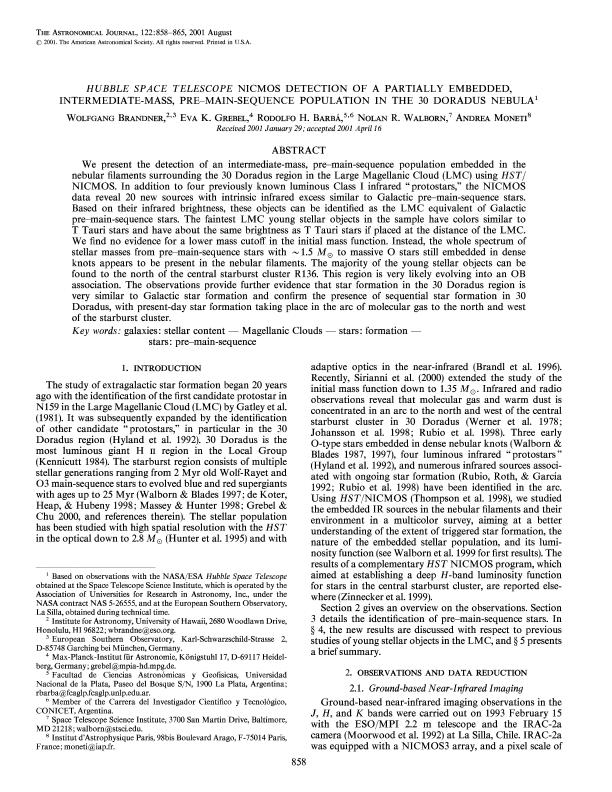Artículo
Hubble space telescope nicmos detection of a partially embedded, intermediate-mass, pre-main-sequence population in the 30 doradus nebula
Fecha de publicación:
12/2001
Editorial:
IOP Publishing
Revista:
Astronomical Journal
ISSN:
0004-6256
Idioma:
Inglés
Tipo de recurso:
Artículo publicado
Clasificación temática:
Resumen
We present the detection of an intermediate-mass, pre-main-sequence population embedded in the nebular filaments surrounding the 30 Doradus region in the Large Magellanic Cloud (LMC) using HST/ NICMOS. In addition to four previously known luminous Class I infrared "protostars," the NICMOS data reveal 20 new sources with intrinsic infrared excess similar to Galactic pre-main-sequence stars. Based on their infrared brightness, these objects can be identified as the LMC equivalent of Galactic pre-main-sequence stars. The faintest LMC young stellar objects in the sample have colors similar to T Tauri stars and have about the same brightness as T Tauri stars if placed at the distance of the LMC. We find no evidence for a lower mass cutoff in the initial mass function. Instead, the whole spectrum of stellar masses from pre-main-sequence stars with ∼1.5 M⊙ to massive O stars still embedded in dense knots appears to be present in the nebular filaments. The majority of the young stellar objects can be found to the north of the central starburst cluster R136. This region is very likely evolving into an OB association. The observations provide further evidence that star formation in the 30 Doradus region is very similar to Galactic star formation and confirm the presence of sequential star formation in 30 Doradus, with present-day star formation taking place in the arc of molecular gas to the north and west of the starburst cluster.
Archivos asociados
Licencia
Identificadores
Colecciones
Articulos(ICATE)
Articulos de INST.D/CS ASTRONOMICAS D/LA TIERRA Y DEL ESPACIO
Articulos de INST.D/CS ASTRONOMICAS D/LA TIERRA Y DEL ESPACIO
Citación
Brandner, Wolfgang; Grebel, Eva K.; Barba, Rodolfo Héctor; Walborn, Nolan Revere; Moneti, Andrea; Hubble space telescope nicmos detection of a partially embedded, intermediate-mass, pre-main-sequence population in the 30 doradus nebula; IOP Publishing; Astronomical Journal; 122; 2; 12-2001; 858-865
Compartir
Altmétricas




